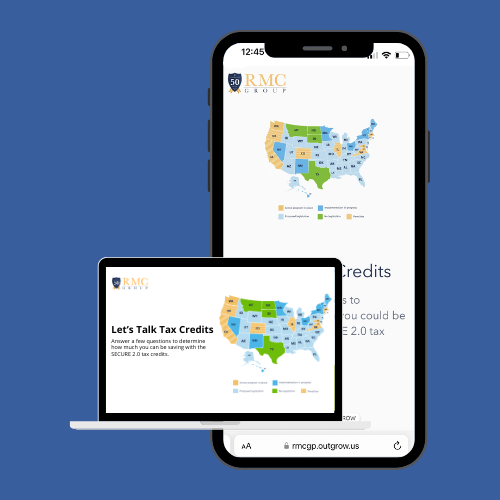Retirement Plans For You and Your Employees
Or speak with a retirement professional today at (239) 298-8210
A Qualified Retirement Plan Helps You Build Retirement Wealth On A Tax-Deferred Basis
Are you a solo practitioner, independent contractor, or business owner with 1 to 10 employees? Can you afford to contribute a portion of your income for the next 5 years?
You May Qualify If...
Do you fit any of the categories below?
Your company may qualify if...
- You own an LLC, Partnership, Sole Proprietorship, S Corp, or C Corp
- Work as an independent contractor
- Earn a net profit on a Schedule C and pay self-employment tax
- Perform consulting or contracting work as a side business
- Freelance full-time

You Begin With Two Basic Plan Types
Choosing the right plan comes down to how much income you want in retirement and how much your business can contribute to the plan over the next few years.
Benefit
Plans
Contribution
Plans
Why a Defined Benefit Plan?
Defined Benefit Plans (also known as “pension plans”) are relatively underutilized and often misunderstood.
These plans provide the largest possible retirement benefit and guarantees that you will receive a benefit in retirement. They let you plan backward by choosing the amount of income you want in your retirement years, then calculating the annual contributions needed to achieve that payout.
A Defined Benefit Plan could let you double or triple what you’d put away with a more traditional plan type, while offering several customization options and advantages.
Plans have the ability to accept substantial contributions paid for by the business for its employees, including owners.
If you haven’t saved enough for retirement, you can make larger contributions later in your career to make up for lost time.
Adding a death benefit is not just a way to protect your loved ones in the event of your passing, it’s also a way to add life insurance to the policy with pre-tax dollars.
Contributions by your business to a Defined Benefit Plan are generally tax deductible.
Plan assets accumulate on a tax-deferred basis. No tax is paid until after retirement. This is a great benefit if you think you’ll be in a lower tax bracket when you retire.
A fully-insured Defined Benefit Plan option can offer a guaranteed retirement benefit that is not subject to the short-term fluctuations of the stock market.
Why a Defined Contribution Plan?
Defined Contribution Plans, better known as 401(k) or Profit-Sharing Plans, are the most popular retirement plans offered by employers today. These plans are an easy way for employees to contribute towards and control how their contributions are invested.
An employer may make contributions to a Profit-Sharing Plan, including matching a certain portion of its employees’ contributions to its 401(k) Plan.
A Defined Contribution Plan is subject to market exposure. An employee’s retirement benefit is dependent upon the performance of the plan’s investments.
An employee can control how their money is invested by selecting from a combination of stocks, bonds, mutual funds, and money market investments.
Why a Defined Benefit Plan?
Defined Benefit Plans (also known as “pension plans”) are relatively underutilized and often misunderstood.
These plans provide the largest possible retirement benefit and guarantees that you will receive a benefit in retirement. They let you plan backward by choosing the amount of income you want in your retirement years, then calculating the annual contributions needed to achieve that payout.
A Defined Benefit Plan could let you double or triple what you’d put away with a more traditional plan type, while offering several customization options and advantages.
Why a Defined Contribution Plan?
Defined Contribution Plans, better known as 401(k) or Profit-Sharing Plans, are the most popular retirement plans offered by employers today. These plans are an easy way for employees to contribute towards and control how their contributions are invested.
Plans have the ability to accept substantial contributions paid for by the business for its employees, including owners.
If you haven’t saved enough for retirement, you can make larger contributions later in your career to make up for lost time.
Adding a death benefit is not just a way to protect your loved ones in the event of your passing, it’s also a way to add life insurance to the policy with pre-tax dollars.
Contributions by your business to a Defined Benefit Plan are generally tax deductible.
Plan assets accumulate on a tax-deferred basis. No tax is paid until after retirement. This is a great benefit if you think you’ll be in a lower tax bracket when you retire.
A fully-insured Defined Benefit Plan option can offer a guaranteed retirement benefit that is not subject to the short-term fluctuations of the stock market.
An employer may make contributions to a Profit-Sharing Plan, including matching a certain portion of its employees’ contributions to its 401(k) Plan.
A Defined Contribution Plan is subject to market exposure. An employee’s retirement benefit is dependent upon the performance of the plan’s investments.
An employee can control how their money is invested by selecting from a combination of stocks, bonds, mutual funds, and money market investments.
What’s The Difference Between a Defined Benefit Plan and a Defined Contribution Plan?
The primary difference between Defined Benefit Plans and Defined Contribution Plans is that with a Defined Contribution Plan, you contribute funds that will have an unknown benefit at retirement.
With a Defined Benefit Plan, the business entity contributes a specific amount of funds based on a set payout in retirement, so you know exactly what you will get in your retirement years.
No Matter Which Plan You Choose, You Will Still Enjoy These Retirement Saving Advantages...
Contributions to both plans may be tax-deductible, and the tax on these plans is deferred until retirement. This is a great benefit if you think you’ll be in a lower tax bracket when you retire.
Your business can make contributions to both types of plans. Depending upon the plan, contributions can be substantial.
There is no tax on plan assets, which allows contributions and earnings to compound at a faster rate.
Both Defined Benefit Plans and Defined Contribution Plans provide a meaningful benefit that can help you attract and retain experienced employees.
Contributions to both plans may be tax-deductible, and the tax on these plans is deferred until retirement. This is a great benefit if you think you’ll be in a lower tax bracket when you retire.
Your business can make contributions to both types of plans. Depending upon the plan, contributions can be substantial.
There is no tax on plan assets, which allows contributions and earnings to compound at a faster rate.
Both Defined Benefit Plans and Defined Contribution Plans provide a meaningful benefit that can help you attract and retain experienced employees.
Get Your Plan Started in 5 Easy Steps
1
Gather
Complete questionnaires and estimate your plan contribution
2
Review
Speak with a Retirement Plan Professional to review your needs
3
Propose
Receive a customized plan proposal for you and your stakeholders
4
Establish
Implement your new plan and complete all paperwork
5
Administer
Receive ongoing reporting and policy administration
Meet with an RMC Retirement Plan Professional today
You can also speak with a retirement plan professional at (239) 298-8210
Want To Learn More About Retirement Planning?
Take a deeper dive into your Retirement Plan options with these resources...
.png?width=500&height=500&name=blogs%20(3).png)
Understanding the Financial Realities of Caregiving Today
The Costs of Caregiving and Planning for the Future As life expectancy continues to rise, more Americans are finding themselves in the role of caregiver.
Read More.png?width=500&height=500&name=case%20study%20(1).png)
Case Study: Small Business Tax Credits
RMC Group was able to help ABC Pools and Spas make substantial contributions to the retirement security of its employees, while reducing its overall costs through the use of available tax credits.
Download.png?width=500&height=500&name=blogs%20(4).png)
Life Insurance vs. Annuities: What You Need to Know
Life insurance and annuity contracts are both products offered by an insurance company. And while both products provide financial security, they are very different...
Read More
Webinar: Mastering Cash Balance Plans
This webinar, hosted by Bryan Foard, QKA, will provide a comprehensive overview of Cash Balance plans, offering participants insights into how these plans work, potential benefits and who the ideal candidate is for maximizing the benefits.
Watch Now.png?width=500&height=500&name=blogs%20(5).png)
Form 8881 - Tax Credit for Small Employer Pension Plan
In an article published in April 2023, we told you about two tax credits added to the Internal Revenue Code by the SECURE Act.
Read More
RMC Group Unveils Tax Credit Calculator for Small Business Owners
RMC Group is thrilled to announce the launch of its new Tax Credit Calculator, which will help small business owners calculate their tax savings.
Learn More
Can’t find what you’re looking for? Explore more insights and tips on our blog—click here to start your search.